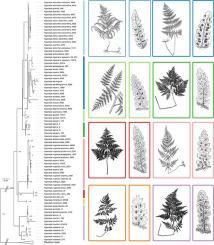Molecular Phylogenetics and Evolution ( IF 3.6 ) Pub Date : 2020-06-06 , DOI: 10.1016/j.ympev.2020.106881 Pedro B Schwartsburd 1 , Leon R Perrie 2 , Patrick Brownsey 2 , Lara D Shepherd 2 , Hui Shang 3 , David S Barrington 4 , Michael A Sundue 4

|
Dennstaedtiaceae has 270 species, a worldwide distribution, and an edge-colonizing habit that is unusual among ferns. Aneuploidy, polyploidy, and hybrids are common in the family. Combining morphology, anatomy, chromosome number, and geographical distributions with our newly generated molecular phylogeny, we provide new insights into the evolution of the family. We paid special attention to Hypolepis. Our molecular dataset of five cpDNA markers is the most comprehensive to date, comprising 72 species (and a total of 98 taxa), of which 33 are Hypolepis (45 taxa). We also generated divergence-time estimates through BEAST with four fossil calibrations. We recovered three sub-families in Dennstaedtiaceae: Monachosoroideae (monogeneric), Dennstaedtioideae, and Hypolepidoideae. Monachosoroideae has a chromosome base number of x = 28; Hypolepidoideae of x = 26; while in Dennstaedtioideae this is still obscure, with different numbers ranging from 30 to 47. Dennstaedtioideae genera require re-circumscriptions because Dennstaedtia is polyphyletic. In Hypolepidoideae, the six genera are monophyletic. Within Hypolepis, seven geographically distinct clades were recovered; but we found no strong morphological characters to define them. Within the family, the long-creeping rhizome evolved with a change in habit: from shade-tolerant to edge-colonizers, to thicket-formers. Short or extremely large leaves are derived conditions. Sorus shape and position, glandular hairs, and prickles are homoplastic. Hybridization/allotetraploidy in Hypolepis can be suggested by the combined data. In our phylogenetic hypothesis, Dennstaedtiaceae originated around 135 Ma, with the split of Monachosoroideae around 94 Ma, and the split between Dennstaedtioideae/Hypolepidoideae around 78 Ma. All extant genera are inferred to be relatively young. Hypolepis started to diversify around 10 Ma, and it probably originated in east Asia and/or Oceania. Hypolepis reached the Neotropics twice: through elements of the Hypolepis rugosula clade (which originated at 7 Ma), and through the ancestor of the Neotropical clade, which originated at 3.1 Ma and was prickly.
中文翻译:

通过扩展的分子系统发育和形态学分析,对蕨类植物蕨科的进化有了新的见解。
蕨科有270种,分布于世界各地,并且在蕨类植物中不常见有边缘定殖的习性。非整倍体,多倍体和杂种在家庭中很常见。将形态,解剖结构,染色体数目和地理分布与我们新生成的分子系统发育相结合,我们为该家族的进化提供了新见解。我们特别注意Hypolepis。我们的五个cpDNA标记分子数据集是迄今为止最全面的,包括72种(共98个分类单元),其中33个是海带鱼(45个分类单元)。我们还通过BEAST和四个化石校准生成了发散时间估计。我们在Dennstaedtiaceae中恢复了三个亚科:Monachosoroideideae(单基因),Dennstaedtioideae和Hypolepidoideae。Monachosoroideae的染色体碱基数为x = 28;x = 26的亚纲 在Dennstaedtioideae科中,这仍然是个晦涩的问题,其数量从30到47不等。Dennstaedtioideae属需要重新划界,因为Dennstaedtia是多系的。在Hypolepidoideae中,这六个属是单系的。在海波利斯,回收了七个地理上不同的进化枝;但是我们没有发现可以定义它们的强大形态学特征。在这个家庭中,根深蒂固的根茎随着习惯的改变而发展:从耐荫性到边缘定殖剂,再到灌木丛。短而大的叶子是衍生条件。形状,体位,腺毛和皮刺都是同型的。结合的数据可以提示海波利斯的杂交/异源四倍体。在我们的系统发育假说中,Dennstaedtiaceae起源于135 Ma,Monachosoroideideae的分裂约94 Ma,Dennstaedtioideae / Hypolepidoideae的分裂约78 Ma。推断所有现存属都相对年轻。Hypolepis在10 Ma左右开始多样化,它可能起源于东亚和/或大洋洲。Hypolepis两次到达新热带:通过Hypolepis rugosula进化枝的元素(起源于7 Ma),并通过Neotropical进化枝的祖先,起源于3.1 Ma且多刺。











































 京公网安备 11010802027423号
京公网安备 11010802027423号